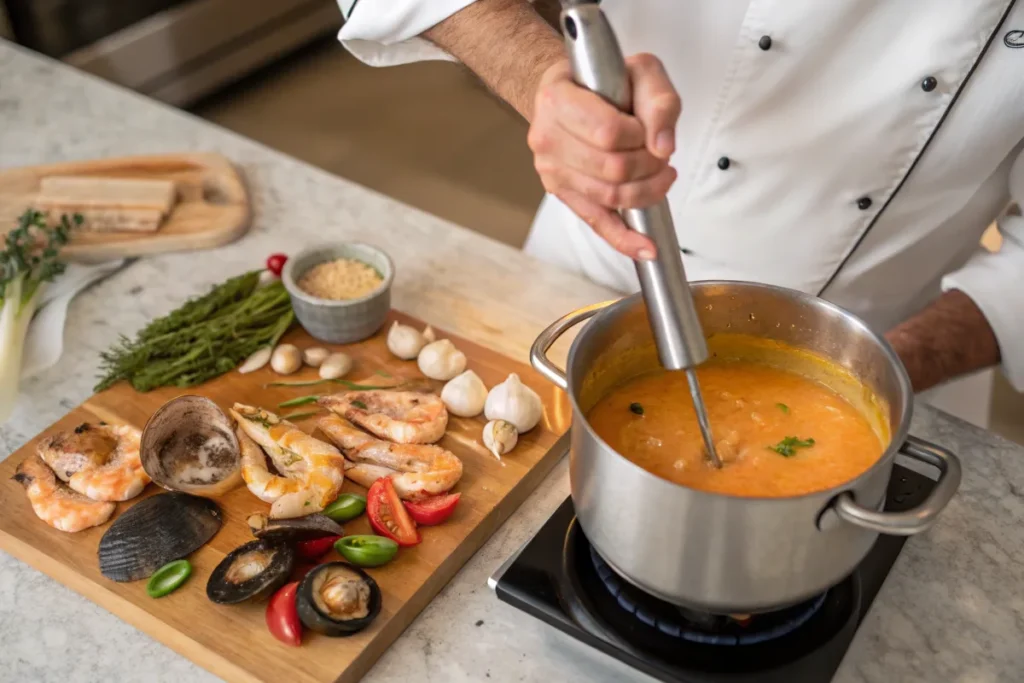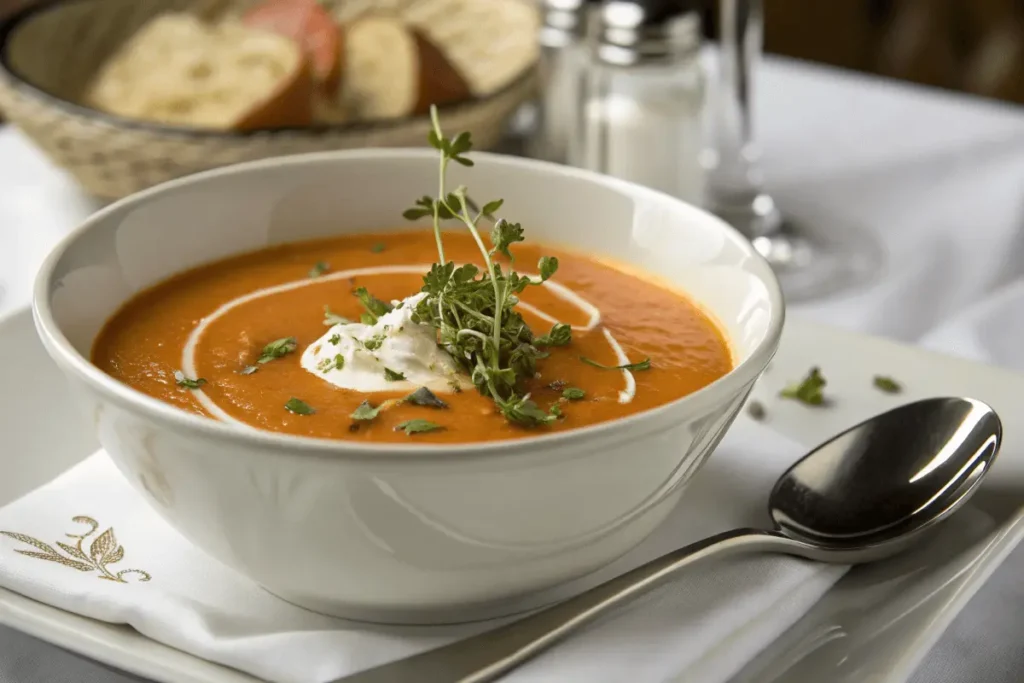A bisque is a smooth, creamy soup. What makes a bisque different from soup involves its key ingredients and preparation method. This article clarifies those differences, helping you understand this delicious culinary creation.
Exploring the Nuances of Bisque and Soup
Many kinds of soups exist worldwide. However, not all are created equal. Bisque, in particular, holds a special place. Therefore, understanding its distinct features is important. What makes a bisque different from soup is primarily in its richness and texture. Bisque typically has a luxurious smoothness. This comes from specific cooking and blending techniques. In addition, its flavor is often more intense.
The Foundations of Soup
Basically, soups are liquid dishes. They usually include water or stock. Additionally, they may have meat, vegetables, or grains. Furthermore, soup’s variety is massive. From light broths to hearty stews, the term ‘soup’ covers a lot. Generally, they are straightforward to prepare. Indeed, many cultures have their own variations. A simple broth, for example, is a basic soup. Conversely, a thick vegetable soup is different.
Defining Characteristics of Bisque
On the other hand, bisque is a specific type of soup. Specifically, it is known for its creamy texture. What makes a bisque different from soup is the method used. Usually, it involves pureeing cooked ingredients, often shellfish. Moreover, it often incorporates cream. Therefore, bisque has a distinctive, opulent consistency. Chiefly, it is more than just a blend of ingredients. It is a carefully crafted culinary experience.
Key Differences in Preparation and Texture
Another big difference is how they are prepared. Soup recipes are often varied. However, bisque recipes follow a more structured approach. Initially, bisque often starts with sauteing aromatic vegetables. Subsequently, a stock is added. Then, the key ingredients, like shellfish, are cooked. Finally, the mixture is pureed until velvety smooth. This process is crucial to what makes a bisque different from soup.

The Role of Cream and Pureeing
Cream is a big part of bisque. For example, it adds richness and body. What makes a bisque different from soup is that it is often finished with cream. Comparatively, other soups may not use cream at all, or use it less. Additionally, bisque is thoroughly pureed. This step eliminates any chunkiness. Consequently, it creates its signature smooth texture. Essentially, the pureeing process is fundamental.
Ingredients That Set Bisque Apart
Another key difference lies in the usual base ingredient. Shellfish, like lobster or crab, are common in bisque. What makes a bisque different from soup is that it often has these flavorful additions. Specifically, the shells of the shellfish are often used to create the stock. This builds a deep and complex flavor profile. In addition, this is less common in standard soups. Therefore, bisque stands out from other soup varieties.
Understanding Flavor Profiles and Culinary Use
Bisque often presents a more sophisticated flavor. Basically, the shellfish base gives it depth. The cream adds a velvety richness. Furthermore, this combination makes it a popular choice. Generally, bisques are used as an appetizer or a special occasion dish. What makes a bisque different from soup in terms of culinary use is its luxurious character. Therefore, it is not just an everyday soup.
Bisque vs. Cream Soup: A Closer Look
While both bisque and cream soup are smooth, they are different. Specifically, cream soup may use many base vegetables. However, bisque focuses on seafood. What makes a bisque different from soup, and cream soup in particular, is the core ingredients. Moreover, bisque generally has a more intense flavor. The cream in both is a compliment to their profiles. Indeed, the overall process affects their texture and taste.
Common Types of Bisque
Several types of bisque exist, featuring diverse seafood. For instance, lobster bisque is a classic example. Furthermore, crab bisque is also very popular. What makes a bisque different from soup is that its main element is usually seafood, which is not the case with other soups. Altogether, the focus on one specific flavor is key. Eventually, each type has its own distinct taste and presentation.
Practical Aspects and Serving Suggestions
Bisque is often served in small portions. Additionally, it is presented in elegant bowls. Specifically, this reflects its more sophisticated nature. Meanwhile, a simple soup can be served in larger amounts, often in a mug. However, both are enjoyable in their own right. What makes a bisque different from soup in terms of serving is its elegance. This is part of the experience.

Garnishes and Pairings for Bisque
Garnishes for bisque are often subtle. For example, a sprinkle of fresh herbs, a small dollop of cream, or a few croutons. What makes a bisque different from soup when it comes to pairings is the elevated nature of the dishes it’s often served with. Comparatively, simple soups might have bigger, more casual additions. Finally, a slice of crusty bread is a compliment to bisque. It also enhances the overall flavor profile.
Home Cooking vs. Restaurant Bisque
Restaurant bisque is usually richer and smoother. Specifically, chefs often use techniques that are harder to replicate at home. What makes a bisque different from soup from a cooking standpoint, particularly for home cooks, is the extra care it requires. Generally, homemade versions might be slightly less refined. Nevertheless, they can still be incredibly tasty. Indeed, both have their merits.
Exploring the Culinary Heritage of Bisque
The origins of bisque are rooted in French culinary traditions. Specifically, it evolved as a way to use all parts of shellfish. What makes a bisque different from soup, in a historical context, is its connection to resourcefulness. Initially, cooks would use the shells and any other parts of the shellfish to create a flavorful stock. Subsequently, it became a distinct type of soup. Thus, bisque carries a significant culinary history.
From Peasant Food to Fine Dining
Originally, bisque was a way to make a satisfying meal with minimal waste. However, as its popularity increased, it found a place in fine dining. What makes a bisque different from soup, from a cultural viewpoint, is its association with sophisticated meals. Eventually, it transformed from a simple dish into an elegant course. Meanwhile, this transformation reflects its unique flavor and texture.
The Evolution of Bisque Recipes
Over time, bisque recipes have seen many changes. Furthermore, different regions and chefs have added their variations. What makes a bisque different from soup now, versus how it was historically prepared, is the use of modern techniques. Specifically, blenders and other tools have helped to create a much smoother consistency. Therefore, the techniques have evolved. Indeed, the core concept has stayed the same.
Detailed Look at the Cooking Process
The cooking process for bisque requires attention to detail. Initially, the shellfish shells are often roasted. Subsequently, they are simmered in stock. This step is crucial for developing the deep flavor. What makes a bisque different from soup during cooking is that it demands a gentle simmering process. Additionally, the puree step needs care to avoid a grainy texture. Thus, each step contributes to the final result.
Step-by-Step Preparation Guide
First, start with fresh ingredients. Afterward, roast the shellfish shells. Next, simmer the shells in stock. What makes a bisque different from soup during preparation is that it typically uses shellfish stock to enhance its flavour. Then, saute the vegetables with aromatics. Combine the stock with vegetables, shellfish, and aromatics, simmer, then puree. Finally, add the cream and season to taste. This process ensures a smooth and rich result.
Common Mistakes to Avoid
One common mistake is overcooking the shellfish. Another is not pureeing it enough. What makes a bisque different from soup when it comes to errors is that its delicate texture can easily be ruined. Therefore, avoid adding the cream too early. It is important to follow the process. Furthermore, ensure all ingredients are compatible. Thus, paying attention to the details is key.
Health and Nutritional Considerations
Bisque, while rich and indulgent, can be part of a balanced diet. Specifically, it provides nutrients from the shellfish and vegetables. However, it’s also high in fat. What makes a bisque different from soup regarding nutritional value is that it’s often higher in calories due to cream and shellfish. Moreover, it should be eaten in moderation. Therefore, consider nutritional needs.
Understanding the Calorie Content
The calorie count in bisque can vary. However, it’s generally higher than many other soups due to the cream and seafood. What makes a bisque different from soup in terms of calories is its fat content. Therefore, portion control is important. Additionally, consider homemade versions to control the ingredients. Thus, be conscious of the calorie content.
Alternatives for Healthier Bisque
To make a healthier bisque, consider using less cream. For example, swap some of the cream for milk or a plant-based alternative. What makes a bisque different from soup, and still satisfying, can be achieved by finding the proper balance. Specifically, one can boost the flavour with herbs and spices. Moreover, you can also use vegetable-based stocks to reduce sodium. Furthermore, focus on fresh ingredients. Therefore, adjust the ingredients to suit your needs.
The Global Appeal of Bisque
Bisque is a dish enjoyed worldwide, featuring different local variations. For instance, in coastal regions, seafood varieties are more common. What makes a bisque different from soup from a global perspective is the adaptability of its basic concept. Meanwhile, it is a versatile dish that can be tailored to regional tastes. Therefore, its popularity transcends cultures. Indeed, this versatility makes it universally appealing.
Bisque in Different Cultures
Exploring different editions of bisque offers a memorable experience. Specifically, the spices and aromatics used in different cultures can enhance the overall flavor profile. What makes a bisque different from soup around the world is the regional additions. Additionally, the use of local proteins adds a unique touch. Consequently, bisque shows up differently around the world. Thus, experiencing these differences is a pleasure.
Adapting Bisque to Local Tastes
Chefs around the globe often adapt bisque to suit local preferences. For example, some might add local spices, while others could use different types of seafood. What makes a bisque different from soup from this standpoint is its flexible nature. Furthermore, these regional variations enhance its appeal. Therefore, it offers something for everyone. Undoubtedly, it showcases the versatile nature of cooking.
Serving and Presentation Tips for Bisque
Bisque, often seen as an elevated dish, calls for an elegant presentation. Specifically, a carefully selected bowl or tureen can enhance the overall dining experience. What makes a bisque different from soup when it comes to serving is the attention to detail. Meanwhile, garnishes can add a touch of freshness and visual appeal. Therefore, the presentation can make a big difference.
Choosing the Right Serving Vessels
The serving vessel is crucial. For example, a shallow bowl allows the bisque to be displayed. What makes a bisque different from soup regarding serving is that it should be shown in a sophisticated way. Additionally, consider using a tureen for a formal setting. Consequently, the choice of packaging matters. Thus, the vessel compliments the dish.
Garnishing for Visual Appeal
Garnishes should be subtle yet effective. For instance, a drizzle of cream or a sprinkling of fresh herbs add a touch of elegance. What makes a bisque different from soup in terms of presentation is its refined appearance. Furthermore, avoid over-garnishing. A simple touch is often more effective. Therefore, the garnishes should compliment the bisque.
Final Thoughts on the Art of Bisque
In conclusion, what makes a bisque different from soup is a combination of factors. Primarily, the shellfish base, the creamy texture, and the sophisticated process of preparation. Additionally, its culinary history and global variations make it a fascinating dish. Therefore, understanding these differences allows one to appreciate both bisque and soup. Ultimately, both types of liquid dishes hold a significant spot in the culinary world. Thus, their varieties ensure there is something for everyone.
Embracing the Diversity of Soups
The world of soups is vast and diverse. However, what makes a bisque different from soup is its unique characteristics. Specifically, its texture, ingredients, and preparation method. Indeed, it is essential to explore different types of soup. Meanwhile, this exploring will enhance your overall understanding of this staple dish. Finally, the diversity of soups offers a harmonious experience.
Enjoying the Delicacy of Bisque
Bisque, with its smooth texture and rich flavor, provides a truly unique culinary experience. What makes a bisque different from soup, specifically from a dining point of view, is its luxurious nature. Likewise, it’s important to appreciate each kind of soup for its distinctive qualities. Moreover, learning about their differences enriches your dining experience. Therefore, enjoying a delicious bisque is a wonderful culinary adventure. Undoubtedly, it compliments any meal.
Frequently Asked Questions
What makes a soup a bisque?
A bisque is a specific type of soup known for its creamy texture and rich flavor. Chiefly, it is made with a shellfish stock and pureed ingredients, often finished with cream. Comparatively, other soups do not always have these traits. Thus, its preparation and key ingredients are what makes a bisque different from soup.
What are the two ingredients that make a bisque different from a puree soup?
The two primary ingredients that distinguish a bisque from a regular pureed soup are shellfish and cream. What makes a bisque different from soup lies in these additions. The shellfish provides a deep, rich base flavor, and the cream creates a smooth and luxurious texture. Furthermore, these ingredients set bisque apart.
What’s the difference between a cream soup and a bisque?
The main difference lies in the main ingredients. While both are creamy, a cream soup may have various vegetables as its base. However, what makes a bisque different from soup is that it typically features a seafood base. Specifically, bisques often have a more intense and complex flavor profile. Generally, they are also richer and smoother.
What is the difference between bisque chowder and soup?
Bisque is always smooth and creamy, whereas a chowder is usually chunkier and heartier. What makes a bisque different from soup, including chowder, is its texture and focus on a pureed consistency. Soup, in contrast, is a broad category. Specifically, chowders often have pieces of vegetables or seafood. Moreover, chowder usually does not have cream as a final addition.

